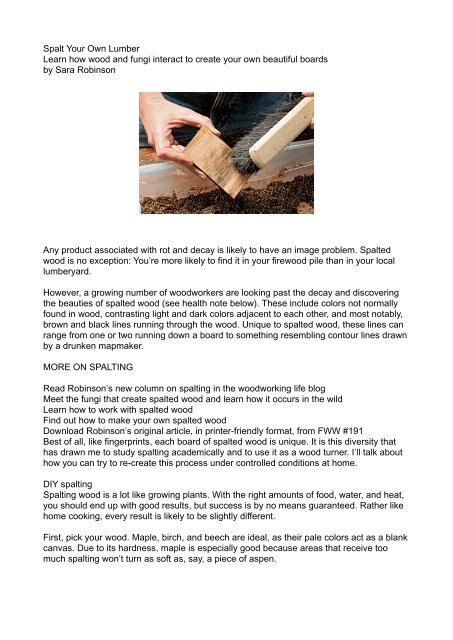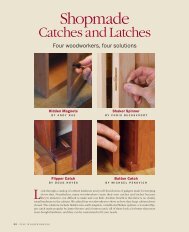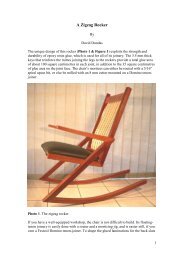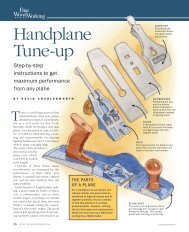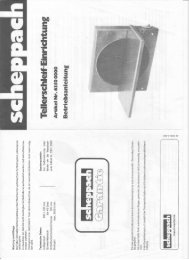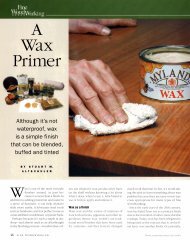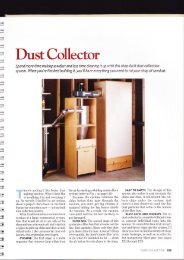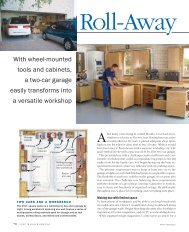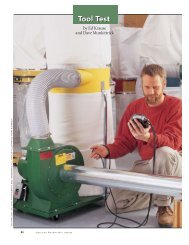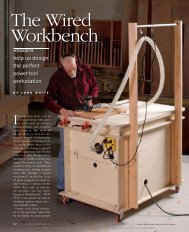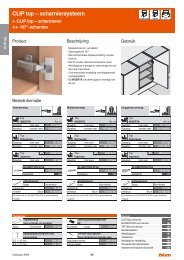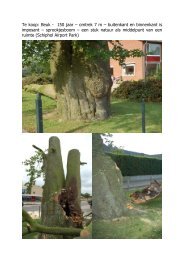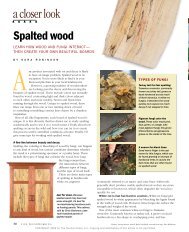Spalt Your Own Lumber Learn how wood and fungi interact to create ...
Spalt Your Own Lumber Learn how wood and fungi interact to create ...
Spalt Your Own Lumber Learn how wood and fungi interact to create ...
You also want an ePaper? Increase the reach of your titles
YUMPU automatically turns print PDFs into web optimized ePapers that Google loves.
Lay dampened boards in the container <strong>and</strong> place pieces of <strong>fungi</strong> in contact with them.<br />
Then cover the boards with more damp vermiculite <strong>and</strong> put a loose lid on the container.<br />
Finally, break the <strong>fungi</strong> in<strong>to</strong> small pieces <strong>and</strong> place them on the <strong>wood</strong>. The board does not<br />
need <strong>to</strong> be covered completely; <strong>how</strong>ever, the more places you stick some spores,<br />
especially on the end grain, the quicker the piece will spalt. Place the bin somewhere<br />
warm <strong>and</strong> dark, <strong>and</strong> wait.<br />
The amount of time it takes for a piece of <strong>wood</strong> <strong>to</strong> start spalting will vary by species, <strong>fungi</strong>,<br />
temperature, <strong>and</strong> the size of the piece. Because moving the <strong>wood</strong> slows the spalting, it is<br />
best <strong>to</strong> place a few small sample pieces of <strong>wood</strong> in the container at the start of the<br />
experiment.
After six weeks, remove a sample block, clean off the vermiculite, <strong>and</strong> inspect the amount<br />
of spalting . Check every two weeks until there is enough.<br />
Starting at six weeks, remove a block every two weeks <strong>to</strong> check it for softness <strong>and</strong> color. If<br />
you like what you have, remove the board from the bin or bag. If not, wait another two<br />
weeks <strong>and</strong> check again.<br />
After removing the spalted board from the vermiculite, allow it <strong>to</strong> air-dry. When ready <strong>to</strong><br />
work, lightly plane or s<strong>and</strong> the surface <strong>and</strong> apply a clear finish <strong>to</strong> display the spalting.<br />
Once you remove the spalted <strong>wood</strong> from its container, make sure <strong>to</strong> air-dry it before use<br />
(unless you will be turning it that day). The <strong>fungi</strong> will continue <strong>to</strong> colonize the <strong>wood</strong> until the<br />
moisture content drops below 20%.<br />
A note on spalted <strong>wood</strong> <strong>and</strong> your health: There is a misconception among many<br />
<strong>wood</strong>workers that working with spalted <strong>wood</strong> is particularly dangerous. Most fungal spores<br />
are about as harmful <strong>to</strong> a healthy adult as <strong>wood</strong> dust, so if you s<strong>and</strong> spalted <strong>wood</strong>, wear a<br />
mask. However, people with immune system disorders should not work with spalted <strong>wood</strong>.<br />
Pho<strong>to</strong>s: Mark Schofield


